
INTERNATIONAL JOURNAL OF THEORETICAL PHYSICS
Scope & Guideline
Fostering Innovation in Theoretical Physics
Introduction
Aims and Scopes
- Quantum Mechanics and Quantum Information:
The journal focuses extensively on quantum mechanics, investigating topics such as quantum entanglement, quantum teleportation, and quantum cryptography. It emphasizes research that enhances our understanding of quantum information theory and its practical applications. - Astrophysics and Cosmology:
Research articles often address cosmological models, black holes, and the implications of quantum mechanics in astrophysical contexts. This includes studies on gravitational waves, dark matter, and the thermodynamic properties of black holes. - Field Theory and High-Energy Physics:
The journal publishes works related to quantum field theory, including the study of particle interactions, gauge theories, and the implications of symmetry in physics. This area explores fundamental questions about the forces governing the universe. - Mathematical Physics:
A significant focus is placed on the mathematical foundations of physics, including the development of new mathematical methods and models that can be applied to physical theories. This includes explorations of algebraic structures and their physical interpretations. - Nonlinear Dynamics and Solitons:
The journal features research on nonlinear systems, soliton solutions, and their applications in various fields, including fluid dynamics and optical systems. This area explores the behavior of complex systems and the emergence of solitons in different contexts. - Quantum Computing and Quantum Algorithms:
There is an increasing emphasis on quantum computing, with papers discussing algorithms, error correction, and the theoretical underpinnings of quantum computation. This includes studies on the implications of quantum mechanics for computational complexity.
Trending and Emerging
- Quantum Technologies and Quantum Computing:
There is a significant surge in research related to quantum technologies, including quantum computing, quantum cryptography, and quantum communication protocols. This trend highlights the increasing importance of quantum mechanics in developing new technologies. - Interdisciplinary Approaches:
Emerging themes indicate a growing trend toward interdisciplinary research that combines physics with fields such as computer science, information theory, and materials science. This reflects the need for collaborative approaches to tackle complex scientific problems. - Quantum Entanglement and Nonlocality:
Research focusing on quantum entanglement, nonlocality, and their applications in quantum information science is on the rise. This includes studies on multipartite entanglement and its implications for quantum networks. - Advanced Cosmological Models:
The journal is increasingly publishing articles on advanced cosmological models that incorporate quantum effects, such as quantum gravity and the implications of quantum mechanics for the early universe. This trend reflects a renewed interest in the intersection of quantum theory and cosmology. - Nonlinear Dynamics and Solitons:
Research on nonlinear dynamics, solitons, and their applications in various physical systems is gaining traction. This includes studies on soliton solutions in fields such as fluid dynamics and nonlinear optics.
Declining or Waning
- Classical Mechanics and Non-Relativistic Physics:
Research centered on classical mechanics and non-relativistic frameworks seems to be declining, as more emphasis is placed on quantum and relativistic phenomena. This shift may reflect the growing interest in quantum mechanics and its applications. - Traditional Statistical Mechanics:
There is a noticeable reduction in the number of papers focusing on traditional statistical mechanics, particularly those that do not incorporate quantum considerations. The trend suggests a movement towards more quantum-centric approaches in statistical physics. - Basic Quantum Foundations:
Topics exploring the foundational aspects of quantum mechanics, such as interpretations of quantum mechanics and basic philosophical discussions, are becoming less frequent. Researchers are increasingly focused on practical applications and advanced theories rather than foundational debates. - Non-Quantum Thermodynamics:
Research articles that do not integrate quantum principles into thermodynamics are appearing less often. The integration of quantum effects into thermodynamic studies is becoming a more prominent area of interest.
Similar Journals
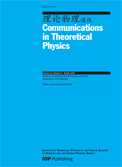
COMMUNICATIONS IN THEORETICAL PHYSICS
Fostering dialogue in the realm of theoretical physics.COMMUNICATIONS IN THEORETICAL PHYSICS is a distinguished journal published by IOP Publishing Ltd, focusing on the broad and evolving field of theoretical physics. With an ISSN of 0253-6102 and an E-ISSN of 1572-9494, this journal provides a platform for the dissemination of innovative research that contributes to the understanding of complex physical concepts. Situated in the United Kingdom, it has established itself as a pivotal resource from 1996 to 2024, achieving a commendable Q2 ranking in the category of Physics and Astronomy (miscellaneous) for 2023. With a Scopus ranking of #18 out of 81 in its category, demonstrating a 78th percentile, this journal plays a crucial role in enhancing scholarly communication among researchers, professionals, and students alike. Although it does not currently offer Open Access options, the journal's comprehensive scope and commitment to high-quality peer-reviewed research underline its significance in the scientific community, making it an essential reading for anyone engaged in theoretical physics.

COMMUNICATIONS IN MATHEMATICAL PHYSICS
Advancing the Frontiers of Mathematical PhysicsCOMMUNICATIONS IN MATHEMATICAL PHYSICS is a premier journal in the realm of mathematical physics, published by Springer and recognized for its rigorous scholarship and comprehensive coverage of the field since its inception in 1965. With an impressive impact factor reflecting its influential contributions—ranking Q1 in both Mathematical Physics and Statistical and Nonlinear Physics—the journal consistently attracts high-quality submissions. It holds notable standings in Scopus, ranked 11th in Mathematical Physics and 12th in Statistical and Nonlinear Physics, marking it as a critical venue for both emerging and established researchers. The journal is dedicated to the dissemination of groundbreaking research and reviews, thereby fostering dialogue and innovation in a constantly evolving discipline. It provides invaluable access to cutting-edge theoretical advancements, making it an essential resource for professionals and students alike engaged in this dynamic field of study.
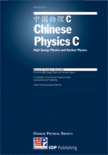
Chinese Physics C
Fostering Innovation in Experimental MethodologiesChinese Physics C is a premier, peer-reviewed journal published by IOP Publishing Ltd, dedicated to advancing knowledge in the fields of Astronomy and Astrophysics, Instrumentation, and Nuclear and High Energy Physics. With an impressive impact factor reflecting its standing in the Q1 quartile across multiple categories, this journal serves as a vital resource for researchers, professionals, and students seeking to engage with cutting-edge developments and experimental findings. Since its inception in 2008, Chinese Physics C has fostered significant collaborations and discussions within the global physics community, enabling easy access to high-quality research through its open access options. Operating from the United Kingdom with a commitment to excellence, this journal not only showcases high-impact papers but also encourages innovative methodologies and interdisciplinary approaches, solidifying its role as an essential platform for dissemination and dialogue in the rapidly evolving landscape of physics.
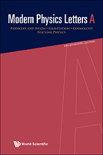
MODERN PHYSICS LETTERS A
Exploring the Depths of Astrophysics and Nuclear PhysicsMODERN PHYSICS LETTERS A, published by World Scientific Publishing Co Pte Ltd, is a distinguished journal in the field of physics that serves as a pivotal platform for researchers, professionals, and students alike. With ISSN 0217-7323 and E-ISSN 1793-6632, the journal has gained international acclaim for its contributions to Astronomy and Astrophysics as well as Nuclear and High Energy Physics. The journal is ranked in Q3 for both Astronomy and Astrophysics and Nuclear and High Energy Physics, showcasing its relevance in these areas, while also achieving a Q2 ranking in the broader category of Physics and Astronomy (miscellaneous). Spanning from 1996 to 2024, MODERN PHYSICS LETTERS A promotes open dialogue and dissemination of pioneering research findings and innovative theories. While the journal operates without an open access option, its rich content is easily accessible through various academic databases, ensuring that vital research is shared widely among the scientific community. Situated in Singapore, this journal plays an essential role in the continuous advancement of the physics discipline, fostering collaboration and knowledge sharing among global researchers.
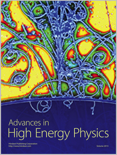
Advances in High Energy Physics
Advancing Knowledge in High Energy Physics for a Brighter TomorrowAdvances in High Energy Physics, published by HINDAWI LTD, is a premier open-access journal dedicated to the progressive field of Nuclear and High Energy Physics. With an ISSN of 1687-7357 and an E-ISSN of 1687-7365, this journal has been at the forefront of scientific discourse in high energy physics since its inception in 2007. The journal is notable for its impact within the community, currently holding a Q2 ranking in 2023 and positioned at #36 out of 87 in its category according to Scopus, highlighting its significant contribution to ongoing research and advancement in the field. Its accessible nature enables researchers, professionals, and students to engage with cutting-edge findings that shape our understanding of the universe. Spanning publications from 2010 through 2024, Advances in High Energy Physics serves as an invaluable resource for those looking to stay informed about the latest developments and methodologies in high energy physics across the globe.
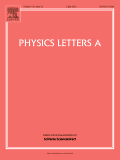
PHYSICS LETTERS A
Advancing the Frontiers of Physics ResearchPhysics Letters A is a renowned scientific journal published by Elsevier, dedicated to the field of physics and astronomy. Established in 1963, it has continuously evolved, offering a platform for the swift dissemination of significant research findings in various branches of physics. As of 2023, it holds a commendable Q2 ranking in the category of Physics and Astronomy (miscellaneous) and ranks 69th out of 243 journals in the same domain according to Scopus, positioning itself in the 71st percentile of academic impact. With its comprehensive scope, Physics Letters A provides a vital resource for researchers, professionals, and students, facilitating academic discourse and advancing knowledge across the field. Although it does not currently offer Open Access options, its rigorous peer-review process ensures high-quality content. It is centrally located in Amsterdam, Netherlands, and continues to be an essential outlet for innovative contributions to the physics community through the year 2024 and beyond.

EUROPEAN PHYSICAL JOURNAL C
Empowering Global Collaboration in ScienceEUROPEAN PHYSICAL JOURNAL C (EPJ C), published by SPRINGER, stands as a premier platform for innovative research in the domains of Physics and Engineering. With its Open Access policy established in 2014, EPJ C ensures that groundbreaking findings are readily available to the global scientific community, enhancing accessibility and collaboration. The journal, indexed in prestigious databases, boasts an impressive impact factor and ranks within the Q1 category for both Engineering and Physics and Astronomy, placing it among the top-tier journals in these fields. Celebrated for its rigorous peer-review process, EPJ C offers a wide-ranging scope encompassing various topics in particle physics, quantum field theory, and related interdisciplinary studies. Its consistent publication since 1991 has fostered a vibrant community of researchers dedicated to advancing knowledge and innovation in physics and engineering. Join the scholarly discussion and contribute to the cutting-edge research made possible through EPJ C's esteemed platform.

JOURNAL OF EXPERIMENTAL AND THEORETICAL PHYSICS
Innovating Understanding in Physics and BeyondJournal of Experimental and Theoretical Physics is a distinguished publication in the field of physics, dedicated to disseminating pioneering research and fostering intellectual discourse in both experimental and theoretical domains. Published by Pleiades Publishing Inc, this journal has established itself as a crucial platform for physicists, with a commendable Q3 categorization in the 2023 rankings within Physics and Astronomy, illustrating its impactful contributions to the discipline. The journal features a wide array of articles that delve into the intricacies of physical theory, experimental techniques, and applications, making it an invaluable resource for researchers, professionals, and students alike. Although it operates under a traditional access model, its longstanding history, dating back to 1980 and converging years through to 2023, underscores its commitment to advancing the frontiers of physics knowledge. The journal is also notable for its engagement in the scientific community, aiming to bridge the gap between theoretical predictions and experimental validations. As a part of Pleiades Publishing, it continues to uphold rigorous standards of academic excellence, inviting contributions that push the boundaries of current understanding and stimulate further exploration in the fascinating world of physics.
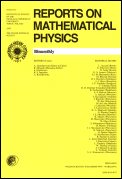
REPORTS ON MATHEMATICAL PHYSICS
Decoding the Language of the Universe through MathREPORTS ON MATHEMATICAL PHYSICS is a distinguished journal published by PERGAMON-ELSEVIER SCIENCE LTD, focusing on the intricate interplay between mathematics and physics. Established in the United Kingdom, this journal has been contributing to the academic community since its inception, publishing significant research findings that explore the theoretical underpinnings of physical phenomena. With an ISSN of 0034-4877 and an E-ISSN of 1879-0674, the journal maintains a consistent publishing history, converging research from 1970 to 2024. It is currently ranked Q3 in both Mathematical Physics and Statistical and Nonlinear Physics categories, reflecting its commitment to maintaining a high standard of scholarly work. Although it lacks Open Access options, its targeted audience of researchers, professionals, and students will find invaluable insights into advanced mathematical methods, statistical applications, and innovative approaches in physics. With its esteemed reputation and critical role in the field, REPORTS ON MATHEMATICAL PHYSICS continues to be an essential resource for those seeking to deepen their understanding of mathematical applications in physical systems.
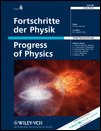
FORTSCHRITTE DER PHYSIK-PROGRESS OF PHYSICS
Unveiling Breakthroughs in Physics and AstronomyFORTSCHRITTE DER PHYSIK-PROGRESS OF PHYSICS, published by WILEY-V C H VERLAG GMBH, is a prestigious academic journal esteemed within the field of physics. With a history spanning over seven decades since its inception in 1953 and a converged publication up until 2024, this journal has established itself as a leading source for groundbreaking research and developments across diverse domains in physics and astronomy. Holding an influential Q1 ranking in the 2023 category of Physics and Astronomy (miscellaneous), it serves as an essential platform for disseminating high-quality research findings and theoretical advancements. Although not an Open Access publication, FORTSCHRITTE DER PHYSIK provides access to critical insights and scholarly discussions that are pivotal for researchers, professionals, and students alike. The journal is committed to contributing to the evolution of knowledge in physics, supporting the academic community through rigorous peer-reviewed articles, reviews, and innovative studies.